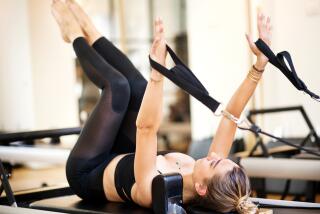Desperately Seeking a Little Spine Tuning
- Share via
I don’t stand up straight. Thanks in part to a boyhood bad habit of slouching, I have carried into my adult life an extra bit of bad back baggage that some days I swear will kill me.
Is this the reason for my aches? Doctors and other health care professionals have told me that bad posture is probably a big factor. The truth is, however, that no one’s really sure what causes chronic lower back pain.
There’s nothing vague or indefinite about the symptoms: soreness, stiffness and lightning-bolt spasms of pain that ignite out of nowhere, striking at the oddest moments: while I’m doing the dishes or making the bed.
My bad back has put me down for days at a time, often making me unable to even stand up straight. A friend of my Chinese-born wife has coined a Mandarin nickname for me, which translates to “old man with his butt sticking out.”
That’s just what I want to be called at age 43.
I’m not alone in my musculoskeletal aches and pains. Bad backs are one of the nation’s most stubborn health enigmas.
Doctors find little agreement about the causes of back pain, and their fuzziness can be a source of great frustration for those of us who go in search of answers to our pain.
As a fellow bad-back sufferer says: “Ask 10 different doctors, get 10 different answers.”
Over two decades, I’ve sought countless solutions, from taking Vicodin (a potent prescription pain reliever), to massage therapy, acupuncture, rigorous stretching and exercise. Some have worked better than others.
But just as the cause for back pain varies with the individual, so too do the treatments. So before you begin any treatment program, first consult your doctor.
I’m at a loss to know why my back has given me such fits over the years. But the roots of my pain, I believe, could go as far back as the ninth grade, when I grew an entire foot. Feeling uncomfortable and gangly, I stooped to remain at eye level with my friends, causing my mother to constantly scold: “John, stand up straight!”
Eventually, my bad posture became compounded by bad habits. I evolved into an adult about as limber as an ironing board. A clown on stilts. One problem was that I was always in too much of a hurry to stretch properly, if at all, before exercising.
I paid the price: snapping both Achilles tendons 10 years apart after failing to stretch before playing basketball.
Now I’ve traded an Achilles tendon for an Achilles back.
Since age 25, my bad-back bouts have come and gone. At the darkest moments, I have consulted doctors who shook their heads in sympathy and suggested that I begin stretching as a way to become more limber. This, of course, made perfect sense to me, but, frankly, stretching is hard, especially when your muscles are as tight as mine. It hurts to get down on the floor each morning to try and work and coax my body into more limber form.
And while I would follow the doctors’ advice religiously for a while, as soon as the pain lessened, I’d slip back to a policy of ignorant neglect.
*
Not long ago, I began road cycling, doing 100 miles a week. Though I rode to lose weight, the bike provided an unintended dividend: As long as I rode, my back pain disappeared.
Then I hit rough road. An accident led me to buy a new bike that wasn’t properly fitted to my frame. One spring day on a long ride in the Santa Monica mountains, I strained my lower back, waking the following morning with a soreness I hadn’t felt in years.
Even though I quit riding, the stiffness remained. I was back at the bad-back drawing board.
My doctor said I had strained a joint in my lower lumbar region. She advised that I lay off the bike for at least several months, until the soreness eased. She prescribed the trusty Vicodin, muscle relaxants such as Robaxin and anti-inflammatories like Naprosyn.
But the pain persisted. I’d be fine for a few weeks, only to suddenly strain my back again amid some simple movement. Walking about half-stooped, I couldn’t help but notice how many others shared my pain: mostly chronically bent older people I’d suddenly see everywhere on the street who obviously failed to take corrective action years ago when they had the chance.
I swore I didn’t want to end up like them.
Finally, I decided that prescription drugs weren’t providing any real solution. I don’t like taking drugs in the first place. Because pain killers and the like can play havoc with your life, make you dopey and sleepy. You can’t drive when taking them. And you have to watch your alcohol intake.
There had to be a better way.
So, I started doing some homework. I asked my doctor about alternative approaches. I talked with friends and family about things they tried. I got on the Internet to learn more about how the traffic jam of muscles in my lower back could be eased and corrected.
Not long ago, during yet another back episode, instead of just popping my painkillers and retiring to the couch, I opted for some alternative treatment: I called Ekke, an Austrian-born massage therapist.
On Wednesday nights, Ekke came to my house to lay me out on his portable massage table, his huge, powerful hands flattening my curved spine like two steamrollers, easing my discomfort, if only for a while.
More lasting was the lower back pain reprieve I received from Baolin Wu, a Beijing-born acupuncturist and master of the ancient Chinese self-healing art of qi gong, which emphasizes breathing, relaxation and purposeful body control.
Over a series of weeks this spring, I returned to his Beijing Medical Center in Santa Monica for massage and acupuncture treatments. Each session, lying on my stomach, feeling the electric pulse surging through the acupuncture needles, I felt the pain and tension ebb. And so I continued my sessions.
More recently, on the advice of my brother Frank, who also has suffered from back pain, I tried Pilates, a popular exercise regimen devised 80 years ago by Joseph Pilates a former German boxer, acrobat and physical therapist. Pilates involves a series of controlled stretching exercises that focus on strengthening muscles and encouraging balance. Pilates can also be done without equipment.
*
My Pilates instructor and the chiropractor he works with were so amazed by my stiffness and posture they took some “before” photographs of me.
I’m still a long way from lower-back nirvana--fumbling along, trying to figure my body out. But people such as Baolin Wu and Nigel Sampson have taught me some important lessons for easing my chronic pain.
For one, stretching isn’t just a once-in-a-while quick fix. To really have it work, I’ll need to stretch my back and leg muscles every morning, whether my back hurts or not.
And I need to concentrate on my posture. I’ve bought a lumbar cushion for back support, and I try to imagine myself as graceful and erect as I sit at my desk and walk down the street.
In the end, staying limber is the key to aging gracefully And painlessly. If I’m lucky, maybe someone will coin a new nickname for me years from now:
Old man with his body standing straight.



